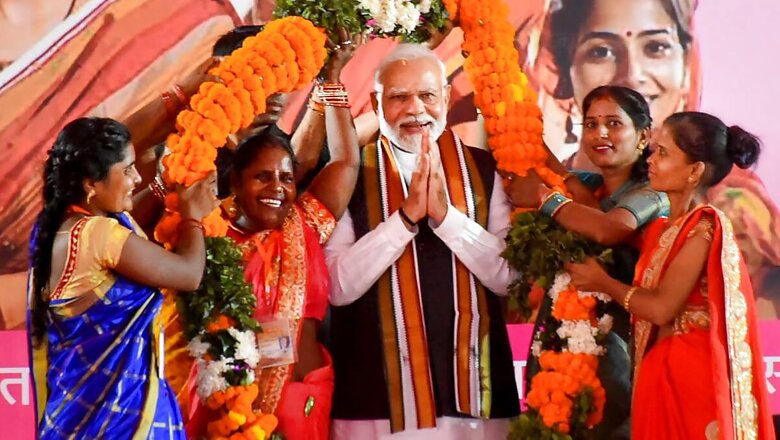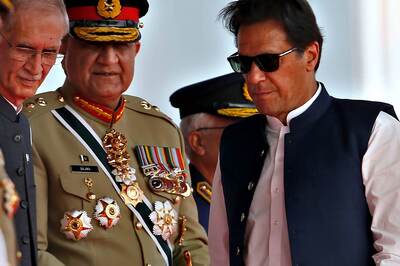
views
According to the UNDP, the labour market is missing out on approximately 172 trillion dollars of total wealth due to inequality. The World Bank has estimated that if women earned the same as men, global human capital wealth could increase by around 20 per cent, with women’s human capital wealth increasing by over 50 per cent. Modinomics is actively working towards achieving equanomics and turning this into a tangible reality.
Through our government’s policies, we are creating a structural and functional framework that empowers and unleashes the potential of ‘Nari Shakti’ (woman power), thereby ensuring that we are on the path to becoming one of the world’s equanomic societies.
India has made significant strides in promoting gender empowerment since gaining independence. In 1951, it was common for girls to be married off at the young age of 15. However, today, the average age of marriage for girls has increased to 22. Furthermore, in 1951, women were expected to have an average of six children, whereas now, the average has been reduced to two children per family or even less. Immediately after independence, our maternal mortality rate was alarmingly high at 2000 per 100,000 of the population. However, today, this rate has significantly dropped to 97 per 100,000 live births.
While the initial six and a half decades of independence primarily focused on empowering women, the era under Prime Minister Modi’s leadership has placed a greater emphasis on women-led empowerment. During this period, women have not only made improvements in health and wealth indicators but have also become the driving force behind our economy. This is where the principles of Modinomics have led to Equanomics, ensuring a more equitable society for all.
The Beijing Declaration and Platform for Action of 1995 serves as a forward-thinking agenda aimed at empowering women. Even today, it remains the most comprehensive global policy framework and blueprint for taking action, providing guidance and inspiration to achieve gender equality and uphold the human rights of women and girls worldwide. This declaration established that gender equality is a shared vision of social justice and human rights, and it emphasises that everyone, particularly governments as the primary duty bearers, has a responsibility to act for gender empowerment.
As a result, more countries began to consider the concept of separate gender budgeting. In India, gender budgeting was adopted in the early 2000s, and gender budget statements have been included in the Union Budget since 2005-06. States are also encouraged to incorporate their gender budget statements into their respective budgets. Therefore, when it comes to gender empowerment, India stands out as a country that effectively coordinates between the Central and state governments, adhering to all fundamental principles. In the Union budget, gender budgets are prepared under Statement 13, which consists of two parts: part A and part B. Part A focuses on schemes specifically targeted towards women and children and sees 100 per cent women specific schemes, while part B highlights schemes that are pro-women and pro-girl centric and constitutes 30-99 per cent budgetary allocation for women.
Today, a total of Rs 3.09 lakh crore has been reported in the Gender Budget Statement 2024-25 (budget estimates) by 43 Ministries/Departments/UTs, which is an increase from Rs 2.23 lakh crore in 2023-24. In either Part A or Part B, 38 Ministries/Departments and five UTs have reported. The gender budget reported in GBS 2024-25 is 38.6 per cent higher than the budget estimates of 2023-24. Furthermore, the share of the gender budget in the total Union budget has risen to 6.5 per cent in 2024-25 from 5 per cent in 2023-24. This significant increase is a result of the continuous commitment of the Narendra Modi government to empower women and girls.
The government’s continuous investment in equanomics is now yielding positive outcomes. From 2011 to 2014, 18 million toilets were constructed, while from 2014 to 2024, the number increased to 115 million. This construction not only improved the health outcomes for women and children but also provided them with dignity. Additionally, from 2017 to 2023, 35.9 million people received maternity benefits, and the female labour force participation rate increased from 23.3 per cent in 2017-18 to 37.0 per cent in 2022-23. Out of the 46 million loans extended under the PM Mudra Yojana, more than 31 million were allocated to women. Currently, over 100 million women are associated with self-help groups, contributing significantly to our economy.
The implementation of the PM Ujjwala Yojana has also improved women’s health by providing over 100 million cooking connections, allowing them to dedicate more time to economic activities. More than 69 per cent of houses constructed under PMAY today are solely or jointly owned by women. According to Women in India’s Startup Ecosystem Report (WISER), the venture capital funding for women-led startups in 2022 was $21.9 billion with 32 per cent of women today holding managerial positions.
The United Nations had praised India’s efforts in gender empowerment during the G20 declaration and expressed its honour to work with the Government of India on women-led development. India, Sweden, and Kenya are leading the way in gender-responsive budgeting at the federal level. Among the 117 countries with available data since 2017, only 18 countries, including Bolivia, India, and France have achieved over 40 per cent representation of women in local governance.
India proudly demonstrates equanomics at the highest level, with a woman leading our country. Therefore, it can be confidently stated that Modinomics is a model that the world can follow to achieve equanomics.
Adarsh Kuniyillam is a Parliament, Policy, and Political Analyst. Views expressed in the above piece are personal and solely that of the author. They do not necessarily reflect News18’s views.




















Comments
0 comment